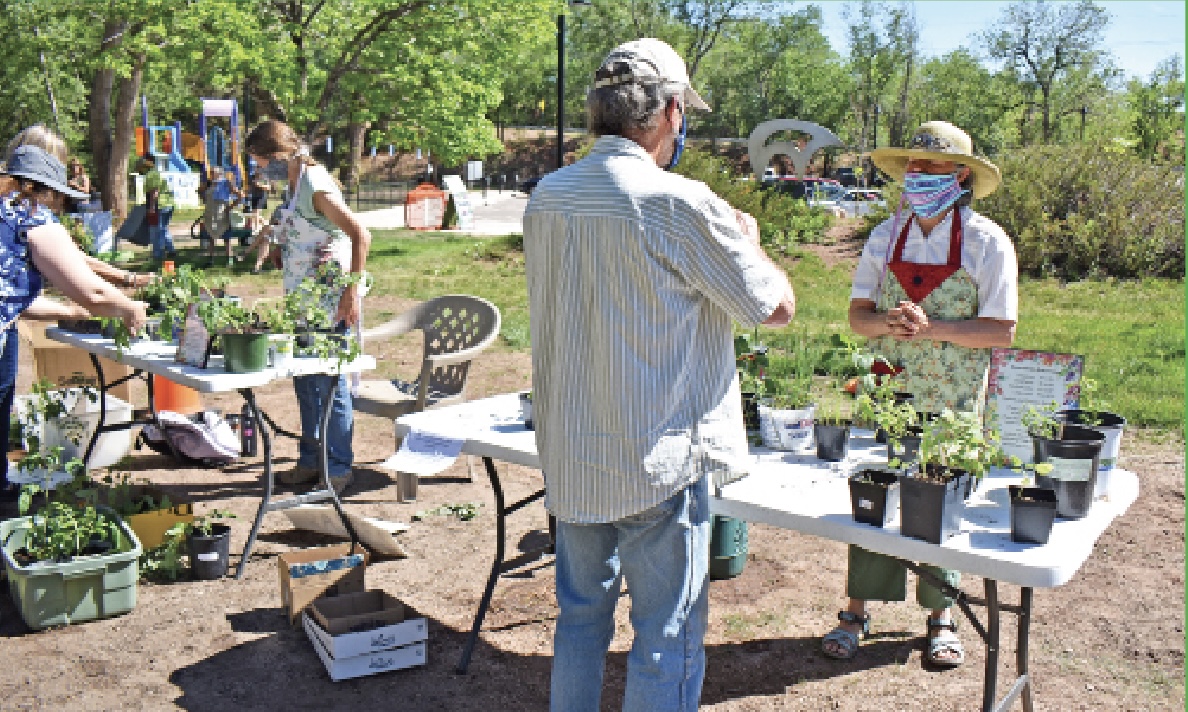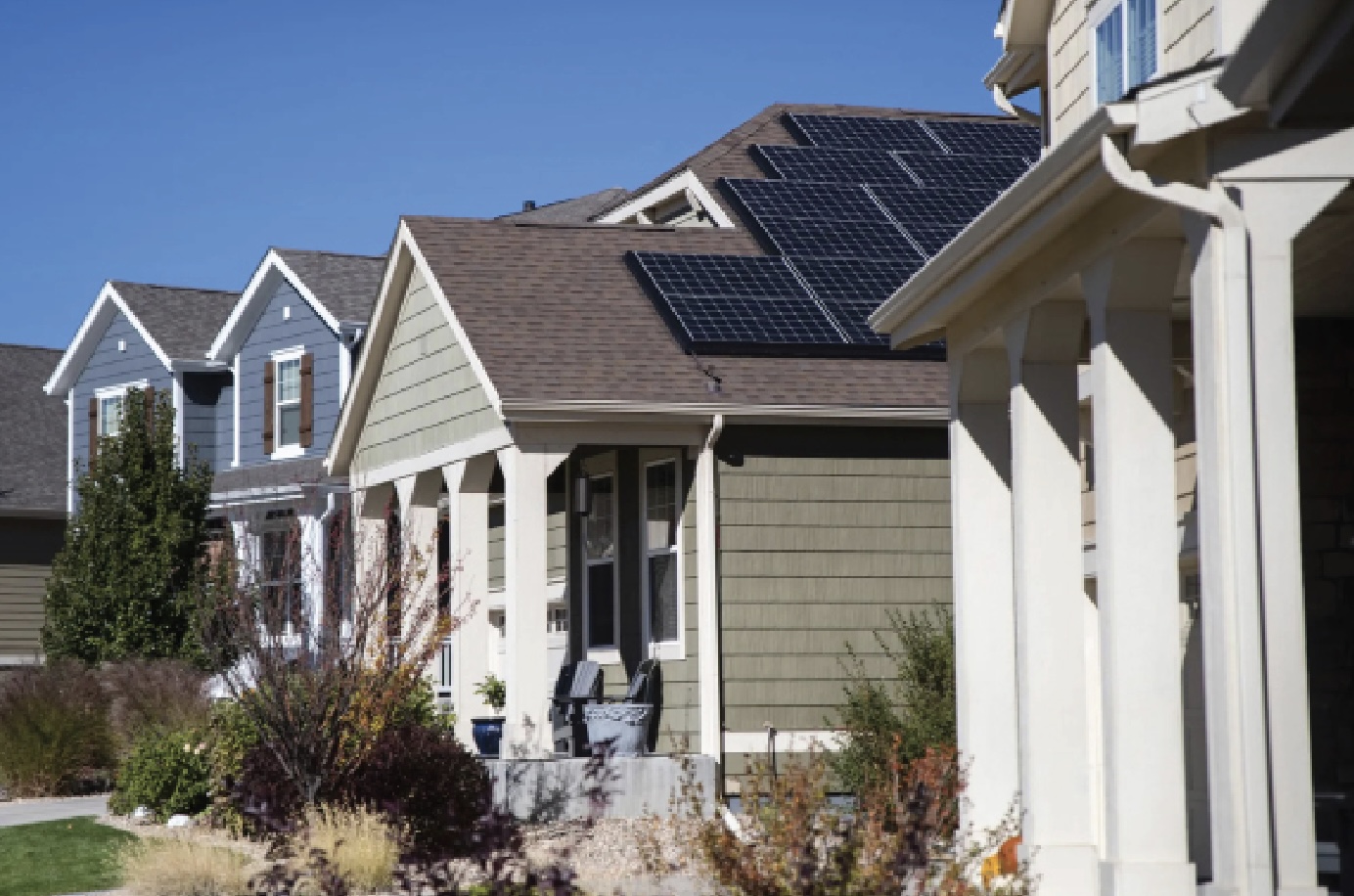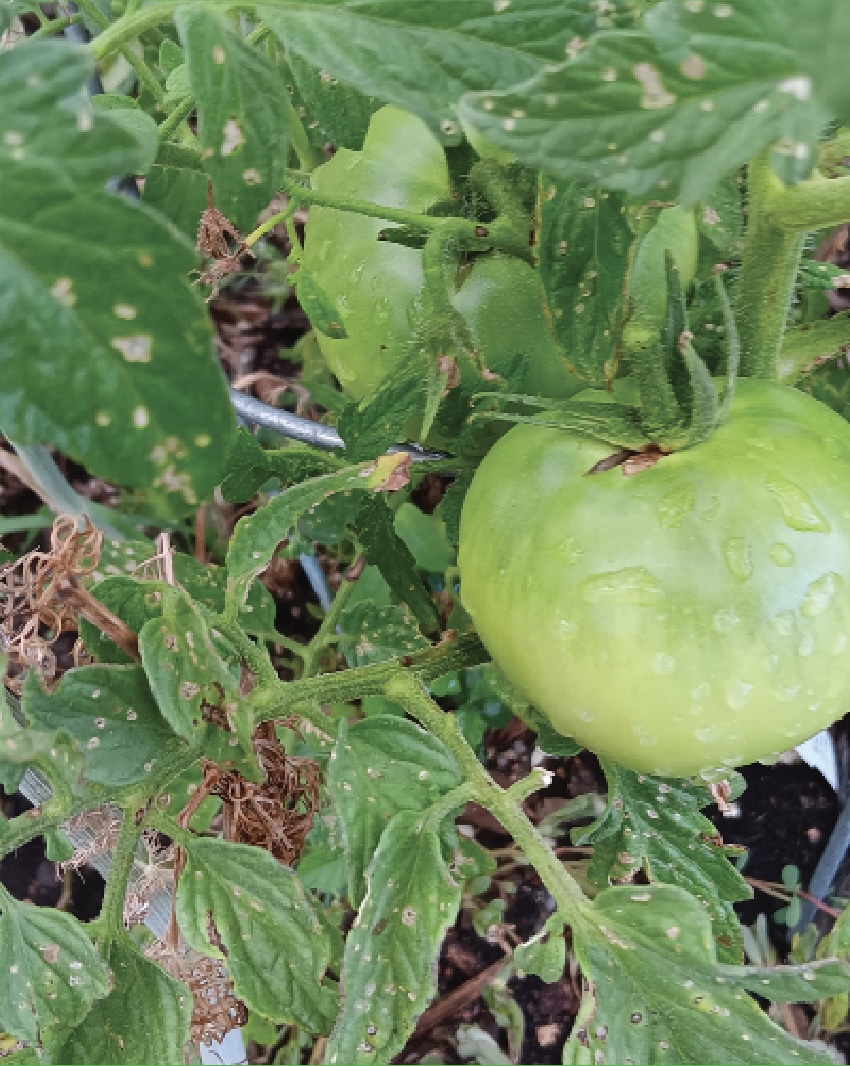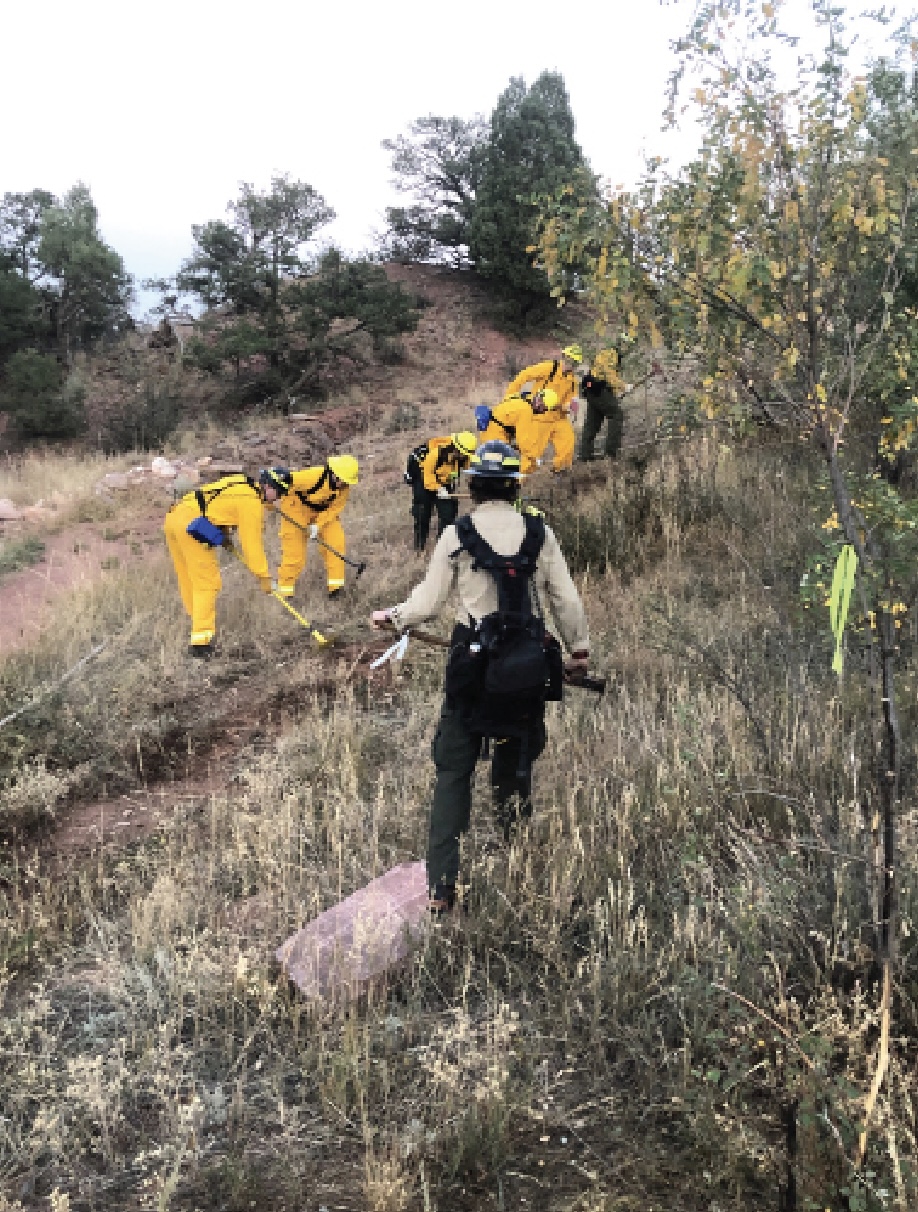Garden Club devoted to greening the community

The Manitou Springs Garden Club was founded in 1993 and meets at 6 p.m. on second Thursdays (except in January). Meetings in colder months take place at the Community Congregational Church’s Community Hall (behind 103 Pawnee Ave.) Summer meetings usually take place in members’ gardens.
The monthly programs include topics such as waterwise and xeriscape gardening; choosing and caring for trees, shrubs and flowers; improving soil; propagation; creating habitats for birds and butterflies; water features; and garden crafts.
The annual plant sale is a favorite event for the club — and the community. This year’s sale takes place 9 a.m.-noon Sunday, May 26, in Schryver Park, 202 Manitou Ave.
It will include vegetables, annuals, perennials, herbs and homegrown plants for reasonable prices.
Proceeds are used for the club’s grants to local organizations and groups working to enhance the enhance the environment and/or increase the community’s sustainability and resilience.
The grants are worth up to $400 and applications are due March 1 each year. To date, the club has given away more than $21,000.
Annual memberships are $20 for an individual and $25 for a family.
Information: manitouspringsgardenclub.org.
Fight garden pests with natural methods and resources
COURTESY OF YOSEF CAMIRE
Beneficial insects are natural predators of garden pests. By encouraging them to live in your garden, you can reduce the need for harmful pesticides and create a more sustainable and healthy environment for your plants.
They include ladybugs, green lacewings and hoverflies. Also, chickadees, titmice and sparrows feed on garden pests like caterpillars, beetles and snails. Encourage them to visit your garden by providing birdhouses, birdbaths and native plantings that offer food and shelter.
Some tips:
Plant diversity: Cultivate a diverse range of plants in your garden. Different insects are attracted to different plants, so planting a variety will help to create a habitat for a diverse range of insects.
Plant flowers: Many beneficial insects are attracted to flowers, so planting a variety of flowering plants in your garden can help attract and retain these insects. Examples include daisies, sunflowers and marigolds.
Avoid chemical pesticides: These can harm beneficial insects, so it is important to avoid using them in your garden. Instead, use natural methods such as hand-picking pests and using row covers to protect plants.
Provide shelter: Beneficial insects need shelter to live and reproduce. You can provide shelter by creating habitat areas such as brush piles, rock piles or logs. These areas can also provide nesting sites for pollinators such as bees and butterflies.
Companion planting: Certain plants attract beneficial insects that will help to control pests on nearby plants. For example, planting dill or parsley near tomato plants can attract predatory wasps that will help control tomato hornworms.
Avoid using chemical fertilizers: These can harm beneficial insects, as well as the environment. Instead, use natural fertilizers such as compost to nourish your plants.
Practice crop rotation: Planting different crops in different areas of your garden each year helps reduce soil-borne diseases and pests.
Yosef Camire owns Ahavah Farm Nursery & Garden Center (www.ahavahfarm.com) and is president of Ahavah Community Initiative (www.ahavahcommunity.org).
How to get solar power for your Colorado home
BY MICHAEL BOOTH, THE COLORADO SUN
Consumer interest in cheap and clean solar energy continues to soar, despite higher interest rates slowing demand for direct-purchase home systems.
Residential solar grew 12 percent in the U.S. last year, according to the Solar Energy Industries Association. Overall solar capacity grew a remarkable 51 percent, as developers plugged in a host of utility-scale solar farms across the nation.
Colorado residents have several ways to link up with solar. If you are a homeowner, first ask professionals for a cost estimate of owning panels.
Four basic factors can help you start assessing whether your home works for rooftop solar arrays. They are:
● One is orientation — if you have a north-only facing roof, there won’t be enough exposure to generate significant power.
● A second factor, says Solar United Neighbors, is shade. If you are surrounded by tall trees or buildings, odds are poor.
● Third is space available: A small home solar system needs about 200 square feet of useful roof space to start.
● Fourth is the age of your roof — if your current roof is 15 years old or more, your cost for a solar system will need to include replacing the roof.
Solar United Neighbors (www.solarunitedneighbors.org) can help with these basic questions, as can private installers. Buying your own system can cost $20,000 to $30,000, but thousands of that can come back to you in a federal tax credit. You then are saving most or all of your monthly electric bill.
If, on some days, you produce more energy than your household needs, you can earn back credits from Xcel or other utilities for sending it back out onto the grid for the utility to “buy.”
Many installers have online calculators that look at a satellite image of a roof and calculate what a system would cost, and how much it would save on your bills. This will give you an estimated “payback” for your investment, often seven years or more.

You might want to price in a battery storage option for your solar. Tesla has popularized the idea with its retail arm installing panels and a Powerwall for storage, to use when the sun is not producing for you.
If buying one yourself is too expensive, look into cooperative buying.
Talk to Solar United Neighbors about its cooperative buying groups. People can join together and make a deal with one installer, giving each homeowner a significant discount on a home system. The installer benefits by having a guaranteed set of projects relatively close together.
If your area doesn’t have a group yet, Solar United puts you on a waitlist and looks for others to join you.
If you can’t pay for your own installed solar system, a lease is another option to consider. The installer takes the risk of paying for the equipment and putting it on your house.
The tradeoff is that you don’t get all the savings — the installer takes some to fund the equipment. You also give up the right to take any tax credits. A more detailed guide to solar home financing options is available at tinyurl.com/CleanEnergyStatesAlliance.
If Option 3 doesn’t make sense, think about joining a community solar garden.
If you live in an apartment or rental home, a community solar project might make sense. You may save about 10 percent on your electricity bill.
Here’s how it works: A developer builds a small solar farm on a parking lot, a farm field or other open space nearby. You then buy or subscribe to a share of the energy that array produces. Your utility company then credits your electricity bill for the amount of energy your share produced that month.
Solar United Neighbors has a handy guide (www.solarunitedneighbors.org/go-solar) to looking up community solar projects in your area. It has useful information, including whether they’re taking more subscriptions or have waitlists, and whether they have a low-income option.
Colorado Springs has a solar co-op, but it’s closed to new members. It started in 2021 and has 143 participants and 25 installations with 157 kilowatts of capacity.
The Colorado Sun is a nonprofit reader-supported news outlet. To learn more and subscribe to free newsletters, go to coloradosun.com.
Helpful tips before you start this year’s garden
Courtesy of Becky Elder
Are you ready for spring? Think soil! Your plants will be only as beautiful and healthy as your soil is beautiful and healthy.
There is an ecosystem below our feet. One square foot of soil is home to more organisms than there are people on the planet. Yes, billions and billions!
The fate of all life above depends on the well-being of the fragile world below. Nurture and protect your soil by being organic in your practices.
Take a look at your garden. Are leaves covering the soil? Leaves are worm food. We all want worms in our soil, so leaving fallen leaves is a perfect step towards more worms and building the soil.
Leaves are nature’s mulch. Leave the leaves. They will be mostly consumed by the worms and soil biota by spring. Excess leaves can go into the compost in May.
How you treat your soil shows in how your garden grows. Before the frosts are gone, a gardener can loosen soil with a potato fork or a broadfork. Stirring the mulch, but not turning or tilling the soil, is key.
Science shows us that rototilling soil, turning it over, is not beneficial to the ecosystem. Tilling is a process learned from industrial agriculture. Not for your gardens.
If your soil needs a boost, top the garden with compost. With rain, the compost will percolate nutrients down through the soil layers. When you plant, add compost to the backfill. Compost and natural processes, including rainfall, are the best fertilizers one can have.
Chemical fertilizers impact the soil for years beyond the initial use. It is the same for chemical pesticides and herbicides. Research has caught up with chemicals and it is certain they damage the soil ecosystem for years after the use.
Please don’t use them. Allow your soil to build upon itself, by allowing nature to follow the course.
Soil amending is for naught if you aren’t mulching to reduce soil stress and evaporation and capture water runoff. Mulch is a protective blanket, especially wood product mulches. Mulch helps keep weeds from becoming established, improves soil conditions and looks great. Wood mulch is far superior to rock mulch.
Get after your weeds early. There are great weeding tools that can help. Tools like hula hoes, hand diggers and hoes get the little plants into the soil as compost and soil food. The variety of weeding tools almost matches the varieties of weeds we want to remove. Any tool is a better choice than chemical treatments.
Use native plants where you can and appreciate hardy-adapted plants that survive the Colorado climate. Be water wise. Use technique and natural moisture over the water spigot. Take the time to spend in your garden. Nature heals.
● Before the spring goes into full swing, check this list:
● Mulches can be topped up to 3 inches. Leaves can stay under the mulch;
● Early weeds are showing. Now is the time to deal with them;
● Sowing seeds can happen indoors;
● Overwintered cannas, dahlias, gladiolus, geraniums, etc., can begin to wake up;
● Clean bird feeders and baths; and
● Practice patience while waiting to plant. Master gardeners suggest waiting until May to plant tender flowers and perennials.
Plots available in the Westside Community Center garden

The city of Colorado Springs is accepting applications for plots in the Westside Community Center garden. The fenced garden, near the corner of North 17th Street and West Platte Avenue, has 71 eight-foot-long beds.
They cost $30 for the season; water and larger tools are included. Information and application: www.coloradosprings.gov/westsidecommunitycenter.
Also, a volunteer is needed to recruit garden members, share and implement rules, communicate with gardeners, among other duties. Information and application: cerv.is/0132×4129.
As warmer weather approaches, think fire mitigation
As we all know, the foothills in this area are prone to wildfire. And even though we’ve had a lot of moisture recently, we have to remain diligent about reducing risks.
According to the Colorado State Forest Service, more than 3 million Coloradans live in the wildland-urban interface, defined as any area where man-made structures are built near, or within, flammable vegetation.
The Manitou Springs Fire Department is available to assess properties for vulnerability and recommend ways to reduce risk. Dry vegetation is not the only factor: Historic properties may have been built using materials and methods that increase their risk for fire.
The city maintains a webpage, www.ManitouSpringsGov.com/501/Wildfire-Mitigation-Site-Assessment, which provides useful information and resources.

One tool is a list of questions called “Am I at Risk?”
1. Is there vegetation close to the building?
2. Is the building on a hill?
3. Does the property have wood-shake siding or shingles?
4. Does it have a deck or porch?
5. Is the property adjacent to natural open spaces?
Property owners can do some relatively simple things to make their lot and buildings safer. Steps include:
1. Clear debris from gutters, eaves and roofs. Rake leaves and keep the lawn hydrated.
2. Check siding for cracks and move flammable materials away from structures.
3. Repair broken windows and replace them with energy-efficient windows.
4. Replace shingles with Class A shingles — check with an insurance agent.
5. Install a sprinkler system that can be set up outside in case of a fire.
6. Collaborate with neighbors to reduce hazardous fuels.
Property owners can replace vegetation within 5 to 6 feet of a structure with crushed rock, concrete, etc. Landscaping should consist of fire-resistant plants, ones with no resins, oils or waxes.
It’s also recommended to trim branches that overhang structures and chimneys, and to seal openings or gaps that are larger than 1/8 of an inch. Screens can be added to vents in the roof and attic.
To request an assessment, contact the MSFD at 719-685-1444.
Additional information: csfs.colostate.edu/wildfire-mitigation.



